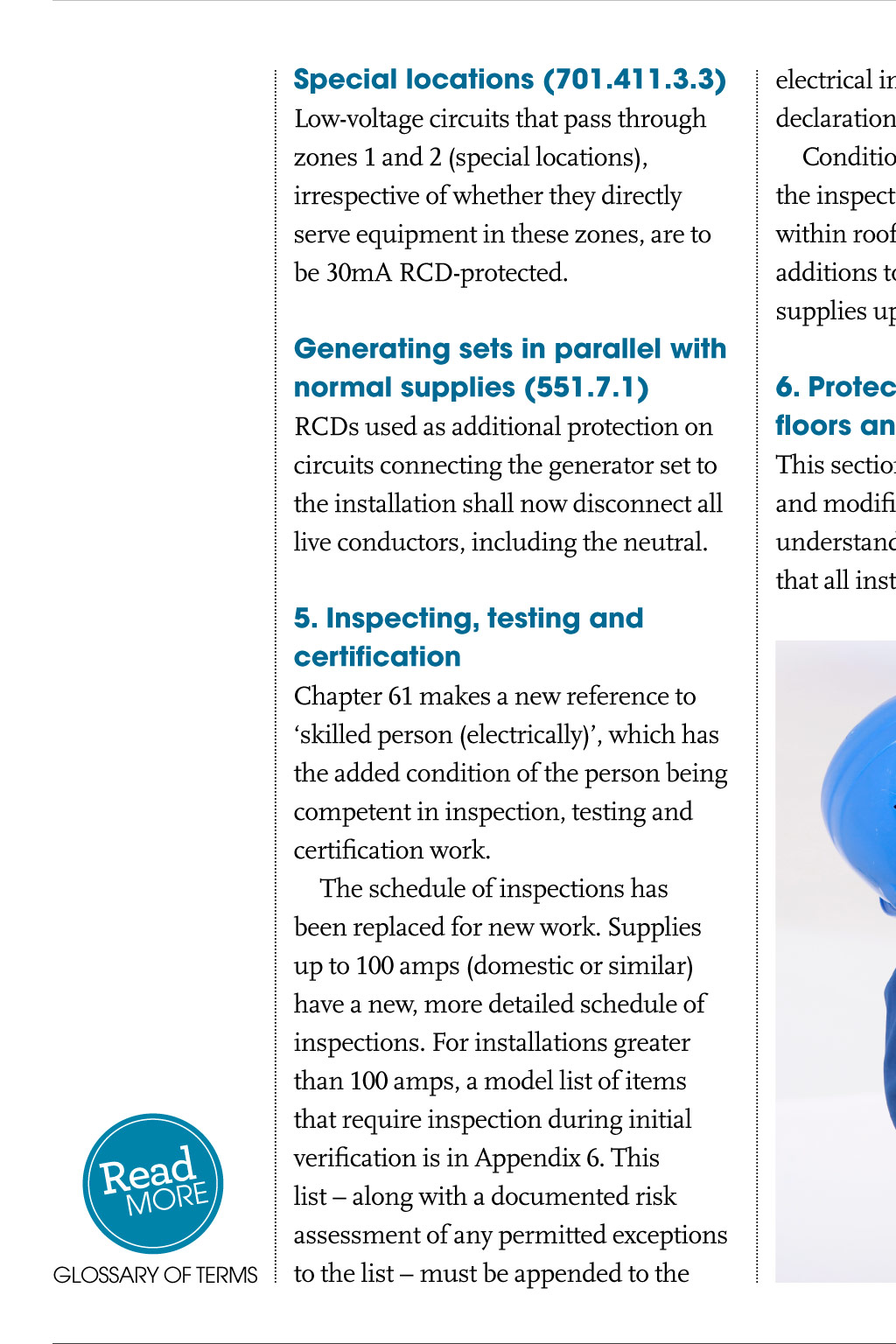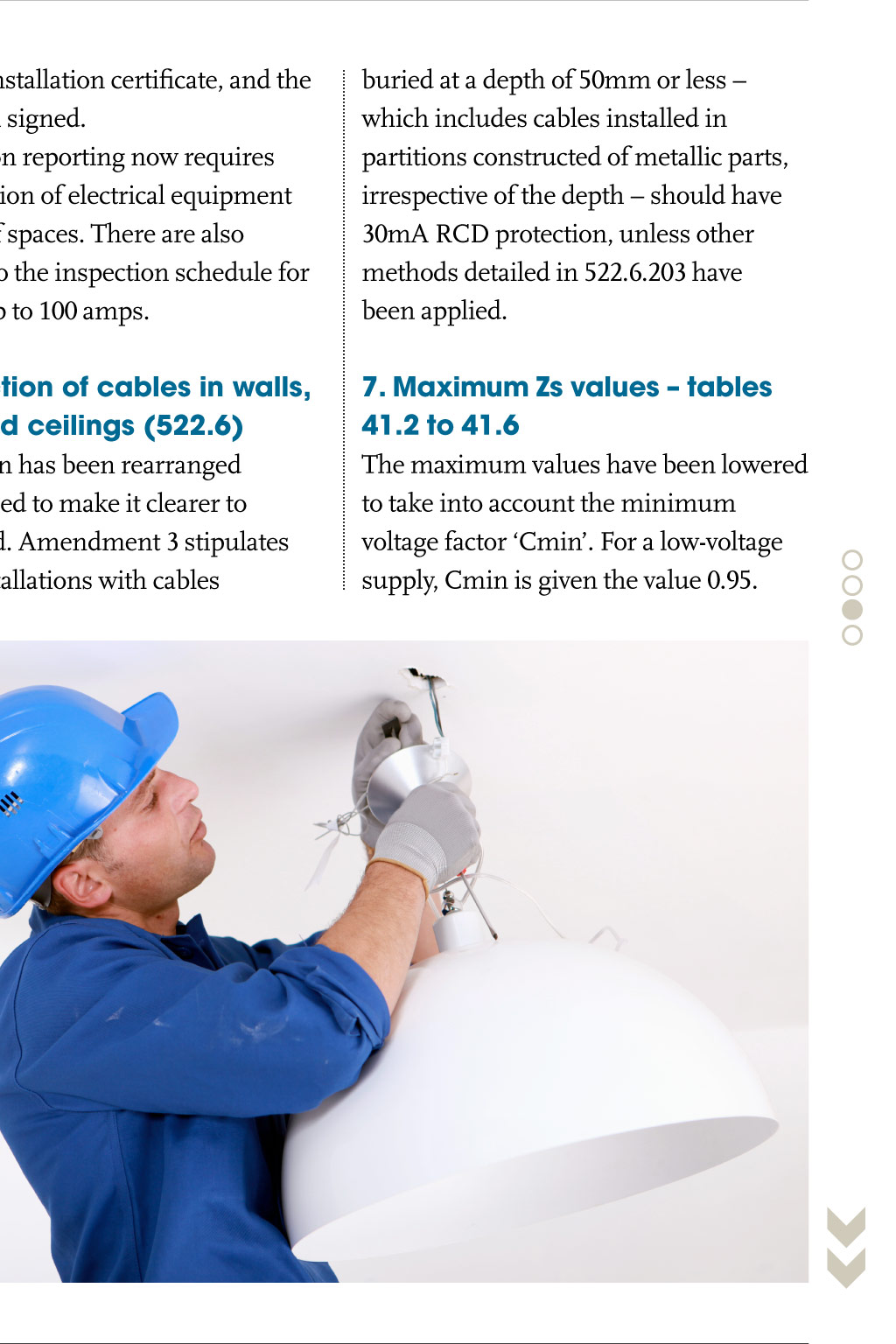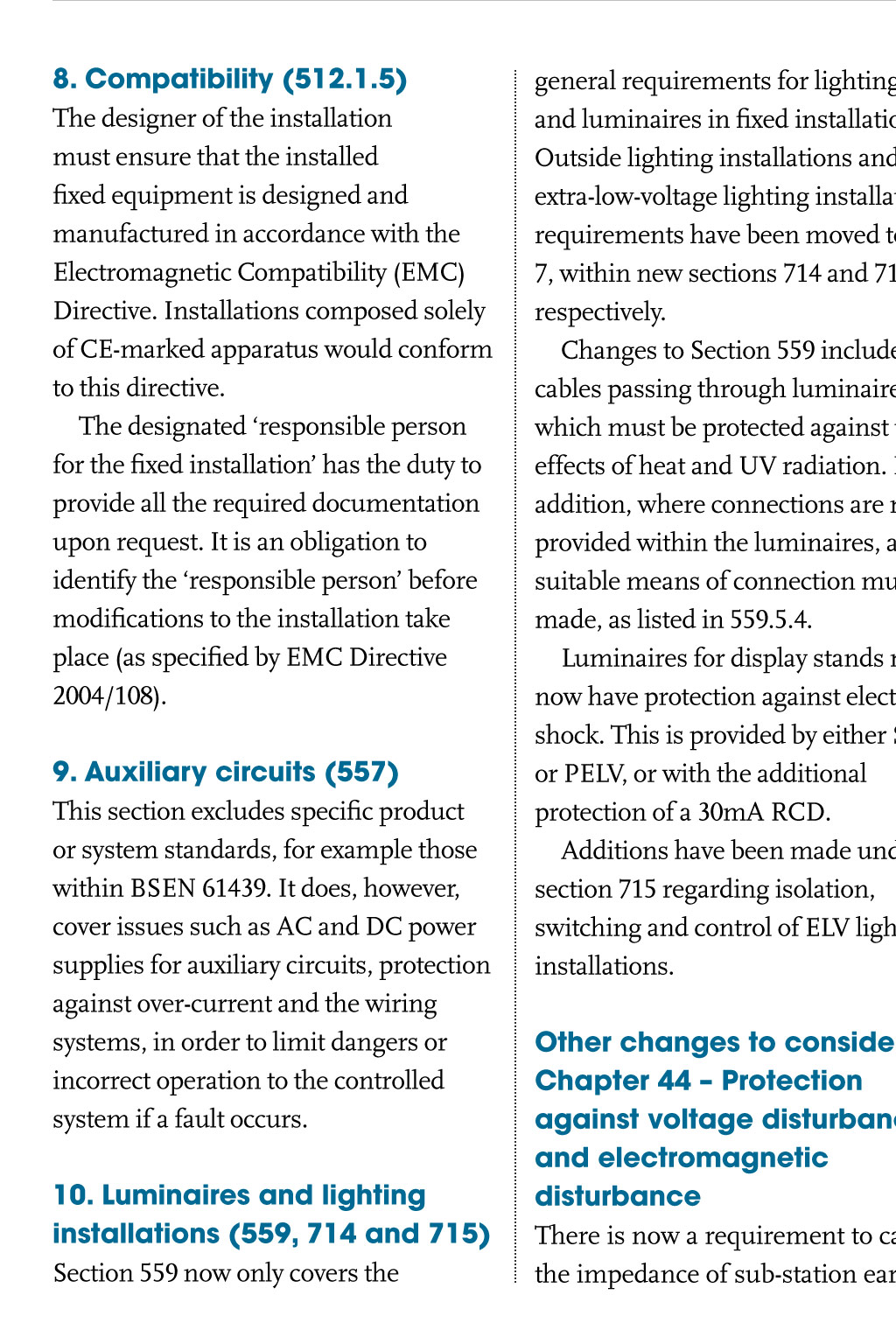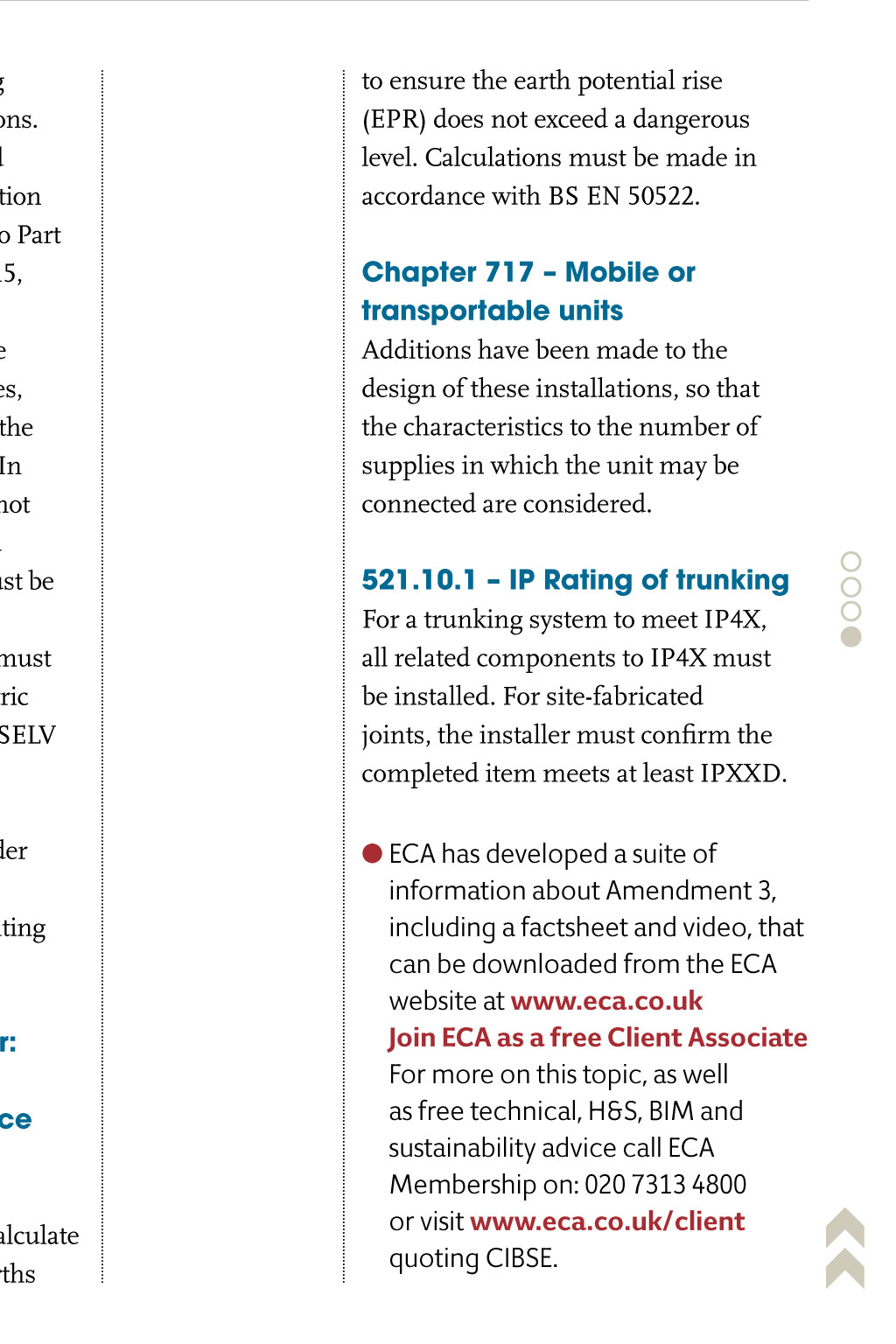
















Knowledge electrical installation a power of good there have been some important changes to the British Standard covering electrical installations. ECA technical director Jim ONeil outlines key elements of Amendment 3 to BS7671:2008, which came into effect on 1 January 2015 This article first appeared in the December 2014 issue of ECA Today. dates of implementation The key dates for implementation of Amendment 3 of the BS 7671:2008 Requirements for Electrical Installations are: 1 January 2015 BS7671:2008+A3 is published. Installations designed after this date may comply and be certified to these new standards, or be designed and certified to BS7671:2008+A2 for a maximum transitional period of six months 1 July 2015 Installations designed after this date must comply fully with BS7671:2008+A3 1 January 2016 Regulation 421.1.200 comes into full effect; this doesnt preclude conformity beforehand. 1. new numbering system The decimal-point numbering system now represents 100 numbers as CENELEC-harmonised references and 200 numbers as UK-only regulations. This system has been used for new regulations. Existing regulations will only adopt this once they have been significantly rewritten. 2. Consumer units in domestic premises (421.1.200) Because of the number of consumerunit fires reported within domestic premises, consumer units and enclosures shall now be manufactured from non-combustible material for example, metal or be installed within a non-combustible enclosure or cabinet with sufficient space around them (132.12 accessibility of electrical equipment). Consumer units and switchgear shall comply with BS EN 61439-3. There is an extended period to 1 January 2016 for the full implementation; however, this doesnt preclude adopting this sooner. 3. Wiring systems in escape routes (521.200) The hazards created by the collapse of wiring systems within escape routes during a fire will now inhibit the use of plastic clip, cleats, ties or PVC trunking and conduit as the sole means of support in these areas. If these methods are used, the cables must be restrained Amendment 3 explained by metallic, fire-resistive supports. This applies to all escape routes, irrespective of any classification. 4. rCds A number of changes make reference to the use of RCDs: additional protection (411.3.3) The definition skilled or instructed person has been deleted. This change doesnt affect the requirements for socket outlets in dwellings, only in special locations (701.411.3.3) Low-voltage circuits that pass through zones 1 and 2 (special locations), irrespective of whether they directly serve equipment in these zones, are to be 30mA RCD-protected. generating sets in parallel with normal supplies (551.7.1) RCDs used as additional protection on circuits connecting the generator set to the installation shall now disconnect all live conductors, including the neutral. eade Rmor GLoSSArY oF TermS commercial and industrial buildings. Therefore, additional protection by means of a 30mA RCD shall be provided for: (i) Socket-outlets with a rated current not exceeding 20 amps (an exception applies if a detailed risk assessment is produced, or the socket is correctly labelled and identified for a particular item of equipment); and (ii) Mobile equipment with a current rating not exceeding 32A for use outdoors. electrical installation certificate, and the declaration signed. Condition reporting now requires the inspection of electrical equipment within roof spaces. There are also additions to the inspection schedule for supplies up to 100 amps. buried at a depth of 50mm or less which includes cables installed in partitions constructed of metallic parts, irrespective of the depth should have 30mA RCD protection, unless other methods detailed in 522.6.203 have been applied. 6. Protection of cables in walls, floors and ceilings (522.6) This section has been rearranged and modified to make it clearer to understand. Amendment 3 stipulates that all installations with cables 7. Maximum Zs values tables 41.2 to 41.6 The maximum values have been lowered to take into account the minimum voltage factor Cmin. For a low-voltage supply, Cmin is given the value 0.95. 5. Inspecting, testing and certification Chapter 61 makes a new reference to skilled person (electrically), which has the added condition of the person being competent in inspection, testing and certification work. The schedule of inspections has been replaced for new work. Supplies up to 100 amps (domestic or similar) have a new, more detailed schedule of inspections. For installations greater than 100 amps, a model list of items that require inspection during initial verification is in Appendix 6. This list along with a documented risk assessment of any permitted exceptions to the list must be appended to the 8. Compatibility (512.1.5) The designer of the installation must ensure that the installed fixed equipment is designed and manufactured in accordance with the Electromagnetic Compatibility (EMC) Directive. Installations composed solely of CE-marked apparatus would conform to this directive. The designated responsible person for the fixed installation has the duty to provide all the required documentation upon request. It is an obligation to identify the responsible person before modifications to the installation take place (as specified by EMC Directive 2004/108). 9. auxiliary circuits (557) This section excludes specific product or system standards, for example those within BSEN 61439. It does, however, cover issues such as AC and DC power supplies for auxiliary circuits, protection against over-current and the wiring systems, in order to limit dangers or incorrect operation to the controlled system if a fault occurs. 10. luminaires and lighting installations (559, 714 and 715) Section 559 now only covers the general requirements for lighting and luminaires in fixed installations. Outside lighting installations and extra-low-voltage lighting installation requirements have been moved to Part 7, within new sections 714 and 715, respectively. Changes to Section 559 include cables passing through luminaires, which must be protected against the effects of heat and UV radiation. In addition, where connections are not provided within the luminaires, a suitable means of connection must be made, as listed in 559.5.4. Luminaires for display stands must now have protection against electric shock. This is provided by either SELV or PELV, or with the additional protection of a 30mA RCD. Additions have been made under section 715 regarding isolation, switching and control of ELV lighting installations. other changes to consider: Chapter 44 Protection against voltage disturbance and electromagnetic disturbance There is now a requirement to calculate the impedance of sub-station earths to ensure the earth potential rise (EPR) does not exceed a dangerous level. Calculations must be made in accordance with BS EN 50522. Chapter 717 Mobile or transportable units Additions have been made to the design of these installations, so that the characteristics to the number of supplies in which the unit may be connected are considered. 521.10.1 IP rating of trunking For a trunking system to meet IP4X, all related components to IP4X must be installed. For site-fabricated joints, the installer must confirm the completed item meets at least IPXXD. ECA has developed a suite of information about Amendment 3, including a factsheet and video, that can be downloaded from the ECA website at www.eca.co.uk Join ECA as a free Client Associate For more on this topic, as well as free technical, H&S, BIM and sustainability advice call ECA Membership on: 020 7313 4800 or visit www.eca.co.uk/client quoting CIBSE. GLoSSArY oF TermS Escape route (see section 3) The path to follow for access to a safe area in the event of an emergency. Risk assessment (see section 4) The management of Health and Safety at Work Regulations 1999 require employers and self-employed people to assess risks to workers, and others, who may be affected by their work or business. In early 2015, a free e-risk assessment will be made available to ECA members. This will allow risk assessments to be created and saved electronically. Skilled person (electrically see section5) Person who possesses as appropriate to the nature of the electrical work to be undertaken adequate education, training or practical skills, and who is able to perceive risks and avoid hazards that electricity can create. Auxiliary circuits (see section 9) Circuits for transmission of signal intended for control, detection, supervision or measurement of the functional status of a main circuit. 522.6.203 (see section 6) a cable shall: (i) Incorporate an earthed metallic covering that compiles with the requirements of these regulations for a protective conductor of the circuit concerned, the cable complying with BS5467 BS6724, BS7846, BS8436, BSEN 60702-1; or (ii) Be installed in earthed conduit complying with BS EN 61386-21 and satisfying the requirements of these Regulations for a protective conductor; or (iii) Be enclosed in earthed trunking or ducting complying with BS EN 50085-2-1 and satisfying the requirements of these regulations for a protective conductor; or (iv) Be provided with mechanical protection against damage sufficient to prevent penetration of the cable by nails, screws and the like; or (v) Form part of a SELV or PELV circuit, meeting the requirements of Regulations414.4 Cmin (see section 7) The minimum voltage factor to take account of voltage variations, depending on the time and place, changing of transformer taps, and other considerations. The introduction of Cmin has altered time and current characteristics for RCDs and protective devices, resulting in changes to figures and tables throughout. In addition, a new table for BS88-2 fuses has been added